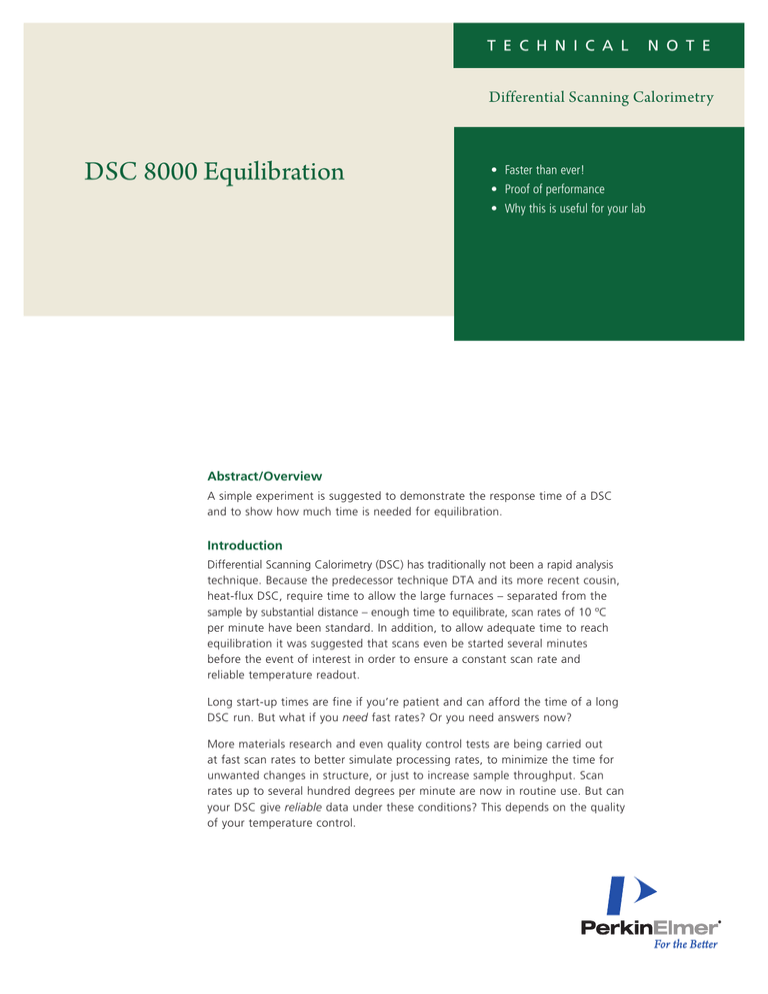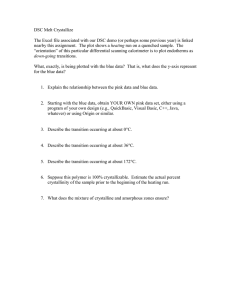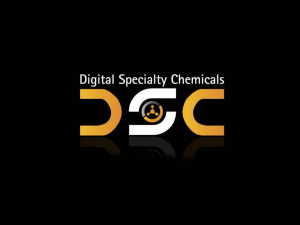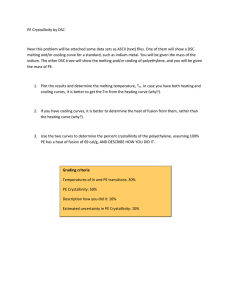
T e c h n i c a l
N o t e
Differential Scanning Calorimetry
DSC 8000 Equilibration
• Faster than ever!
• Proof of performance
• Why this is useful for your lab
Abstract/Overview
A simple experiment is suggested to demonstrate the response time of a DSC
and to show how much time is needed for equilibration.
Introduction
Differential Scanning Calorimetry (DSC) has traditionally not been a rapid analysis
technique. Because the predecessor technique DTA and its more recent cousin,
heat-flux DSC, require time to allow the large furnaces – separated from the
sample by substantial distance – enough time to equilibrate, scan rates of 10 ºC
per minute have been standard. In addition, to allow adequate time to reach
equilibration it was suggested that scans even be started several minutes
before the event of interest in order to ensure a constant scan rate and
reliable temperature readout.
Long start-up times are fine if you’re patient and can afford the time of a long
DSC run. But what if you need fast rates? Or you need answers now?
More materials research and even quality control tests are being carried out
at fast scan rates to better simulate processing rates, to minimize the time for
unwanted changes in structure, or just to increase sample throughput. Scan
rates up to several hundred degrees per minute are now in routine use. But can
your DSC give reliable data under these conditions? This depends on the quality
of your temperature control.
How Power Controlled DSC Works
The PerkinElmer® power controlled DSC series work under
different measuring principles than all other commercial
DSCs, which use the heat-flux principle, or by measuring
a temperature difference between two samples heated by
a single relatively large, external furnace. Power controlled
DSC uses two tiny micro-furnaces intimately coupled to
the sample and reference positions. It employs a different
measuring circuit that uses tight feedback control to maintain the temperature of the sample and reports the power
required to do so. The result is extremely tight temperature
control. Here’s the proof.
Temperature Control on a Power Controlled DSC
The following simple experiment proves beyond doubt the
unique temperature control capability of power controlled
DSC. Here we use a calibrated DSC to heat a sample of indium
at 500 ºC per minute from 40 ºC to 152 ºC, and then heat
at 10 ºC per minute through the indium melt which starts
at 156.6 ºC. See Figure 1. The details of the experiment are
listed in the appendix.
Figure 2. Indium melting after a fast heat up. The green curve is that of the sample
temperature (extreme left axis), and is seen to ramp from 40 to 152 ˚C in a fraction of a minute. The blue curve is the derivative of the sample temperature, which
is the heating rate (inner left axis). Note: temperature quickly (in 8 seconds) rises
to 500 ˚C/min and remains constant until the control temperature reaches 152 ˚C.
It then rapidly re-equilibrates to 10 ˚C/min as indium is heated through the indium
melt (heat flow on right hand axis). Actually, it is obvious from the data we could
have heated to an even higher temperature before switching to 10 ˚C/min!
Results
Figure 2 shows this 1.4 minute test on a time scale.
Figure 3. The same data shown versus the sample (sensor) temperature.
Notice that the heating rate achieves 500 ˚C/min by 60 ˚C. This is the kind of
temperature control that is needed if you want to use fast heating rates and get
useful data without starting at a deep subambient temperature.
Figure 1. The DSC method: fast heat to 152 ˚C, then 10 ˚C/min through the
indium melt.
Figure 4. The same data as Figure 3 but with the indium heat flow scaled up
and the melting calculation performed. Notice that despite the short time for
equilibration at 10 ˚C/min, the temperature and melting energy are accurate.
2
Why is rapid, accurate temperature control like this
important to you? You need:
• High sensitivity for measuring the glass transition of a low
concentration amorphous component so you want to heat
very rapidly
• To heat a sample very rapidly to keep it in an unstable form
through a transition
• To heat a sample in a metastable state to a temperature just
below a transition and immediately measure that transition
at a slower rate before it changes.
• To measure the reaction kinetics of a reactive mixture by
heating through the reaction at a slow rate then starting
immediately at an elevated temperature
• To characterize crystallization behavior and need to stabilize
the temperature rapidly after cooling from the melt
Appendix: Experimental Details
• The DSC was configured with a refrigerator-type cooling
device and using 20 cc/min nitrogen gas purge. If helium
is used as a purge gas the heat flow equilibration of the
sample specimen is further improved from what has been
shown. Standard (not autosampler type) platinum lids were
in use.
• The DSC was calibrated in normal fashion using indium as
the sole calibrant. No special conditions were used to setup
the instrument. It was an old “work horse” model, but a
genuine power controlled DSC.
• The indium sample (~2 mg) both for calibration and for
the fast heat-up scan were crimped in a standard pan and
flattened to ensure good thermal contact. One way to
achieve this is to use the eraser on the end of a pencil to
depress the crimped pan against a flat surface before loading.
• To shock cool the sample in a controlled and reproducible
way
These tests would likely not be possible with a DSC that employs
a large furnace because the temperature would not stabilize in
such a short time. Some instruments provide data correction for
thermal lags that make the data appear that the sample is equilibrated more rapidly than it actually is. They show the data as it
would be under ideal temperature control. This may mask a
problem by making the data look better than it is.
With a power controlled DSC, the sample is actually controlled
to a tight temperature. Therefore, there is no need to correct
to a presumed model.
PerkinElmer, Inc.
940 Winter Street
Waltham, MA 02451 USA
P: (800) 762-4000 or
(+1) 203-925-4602
www.perkinelmer.com
For a complete listing of our global offices, visit www.perkinelmer.com/ContactUs
Copyright ©2010, PerkinElmer, Inc. All rights reserved. PerkinElmer® is a registered trademark of PerkinElmer, Inc. All other trademarks are the property of their respective owners.
009125_01



